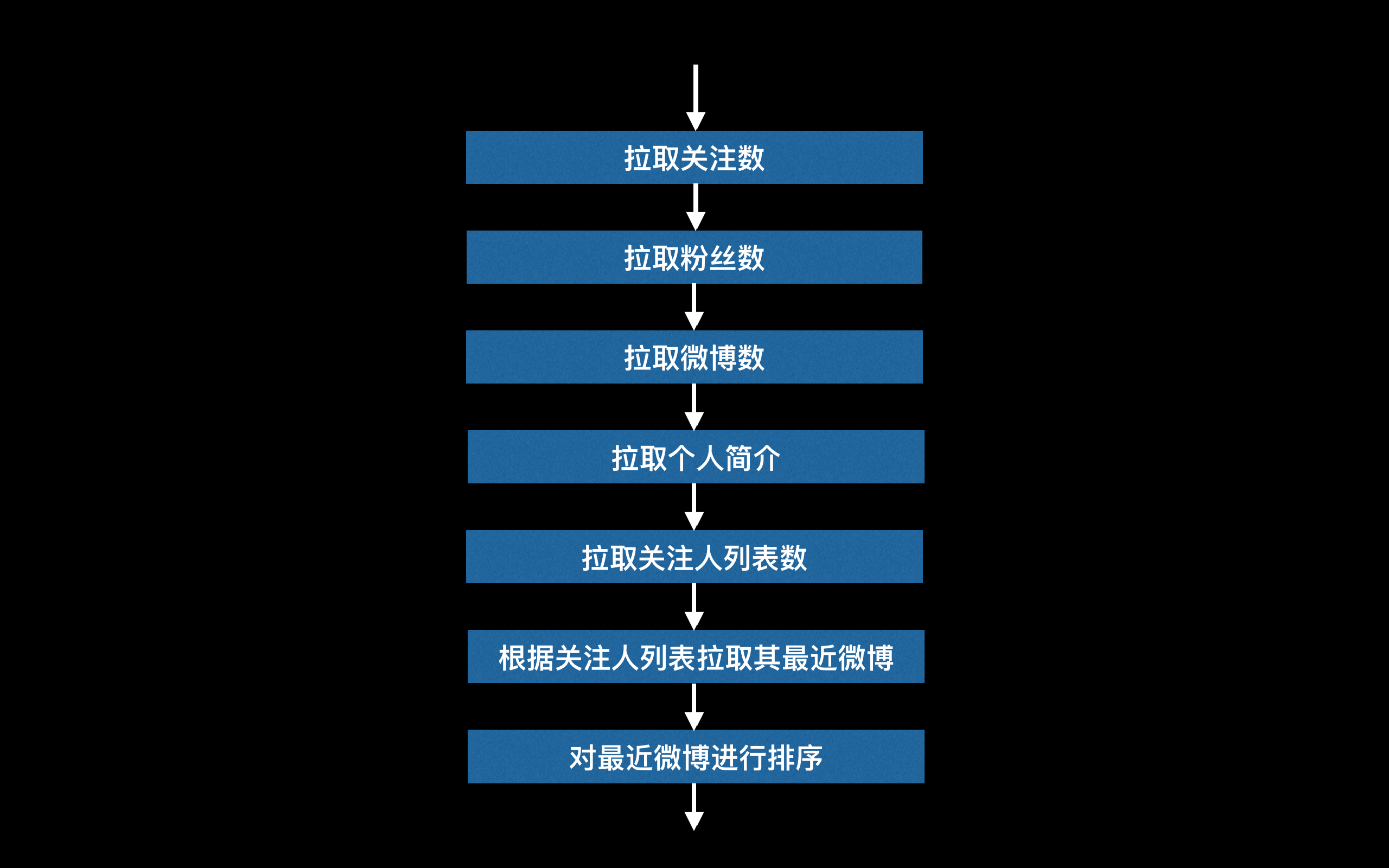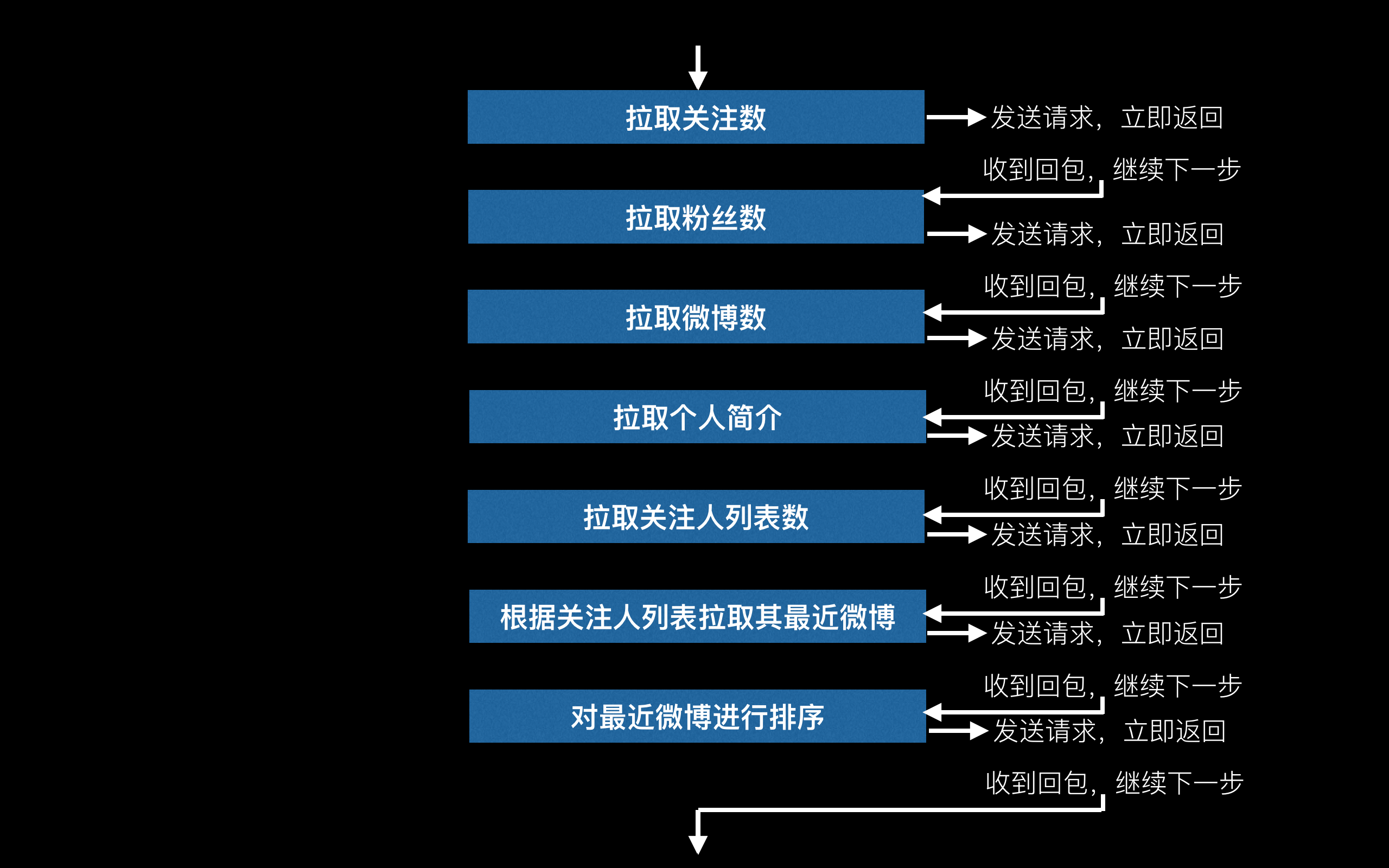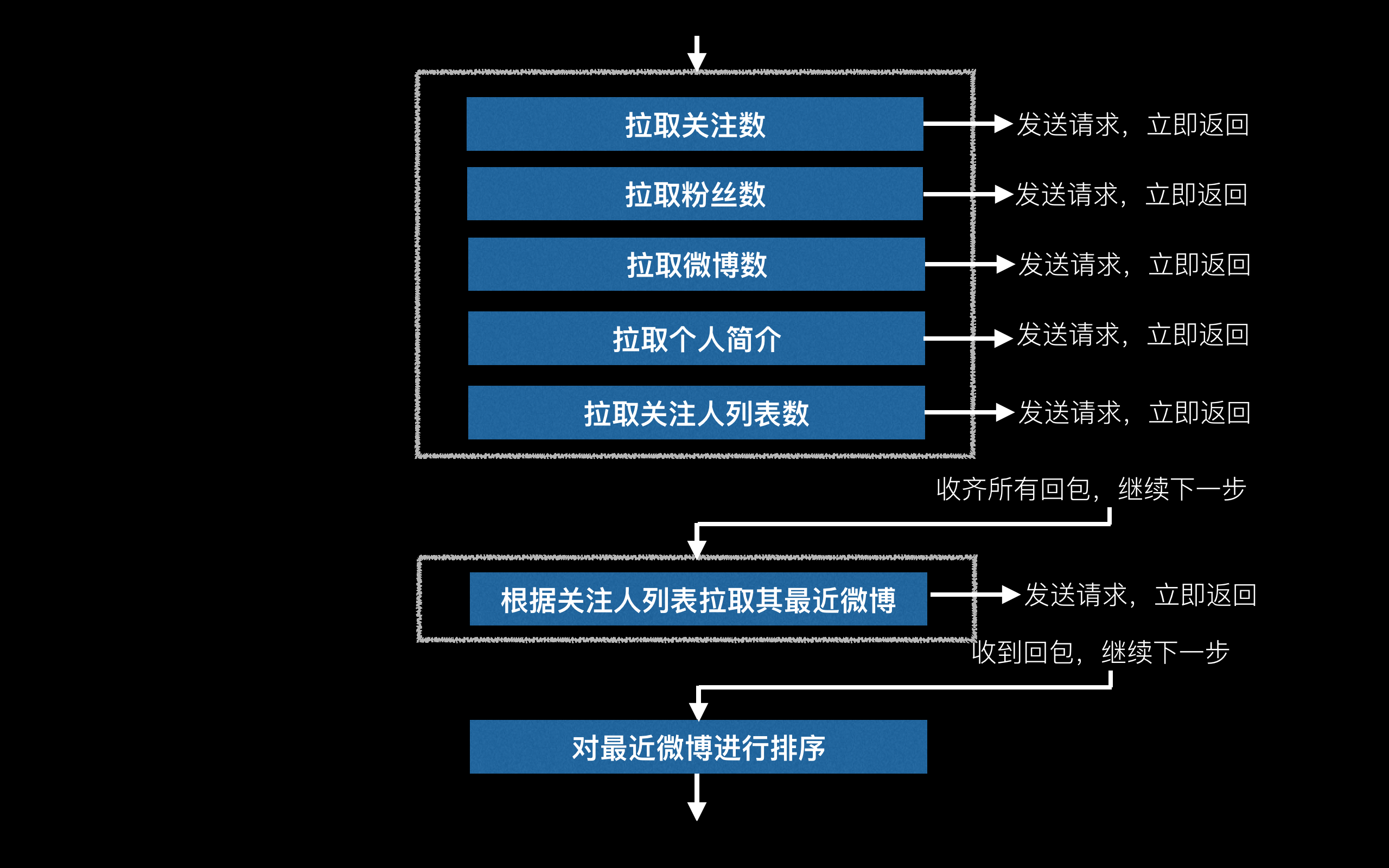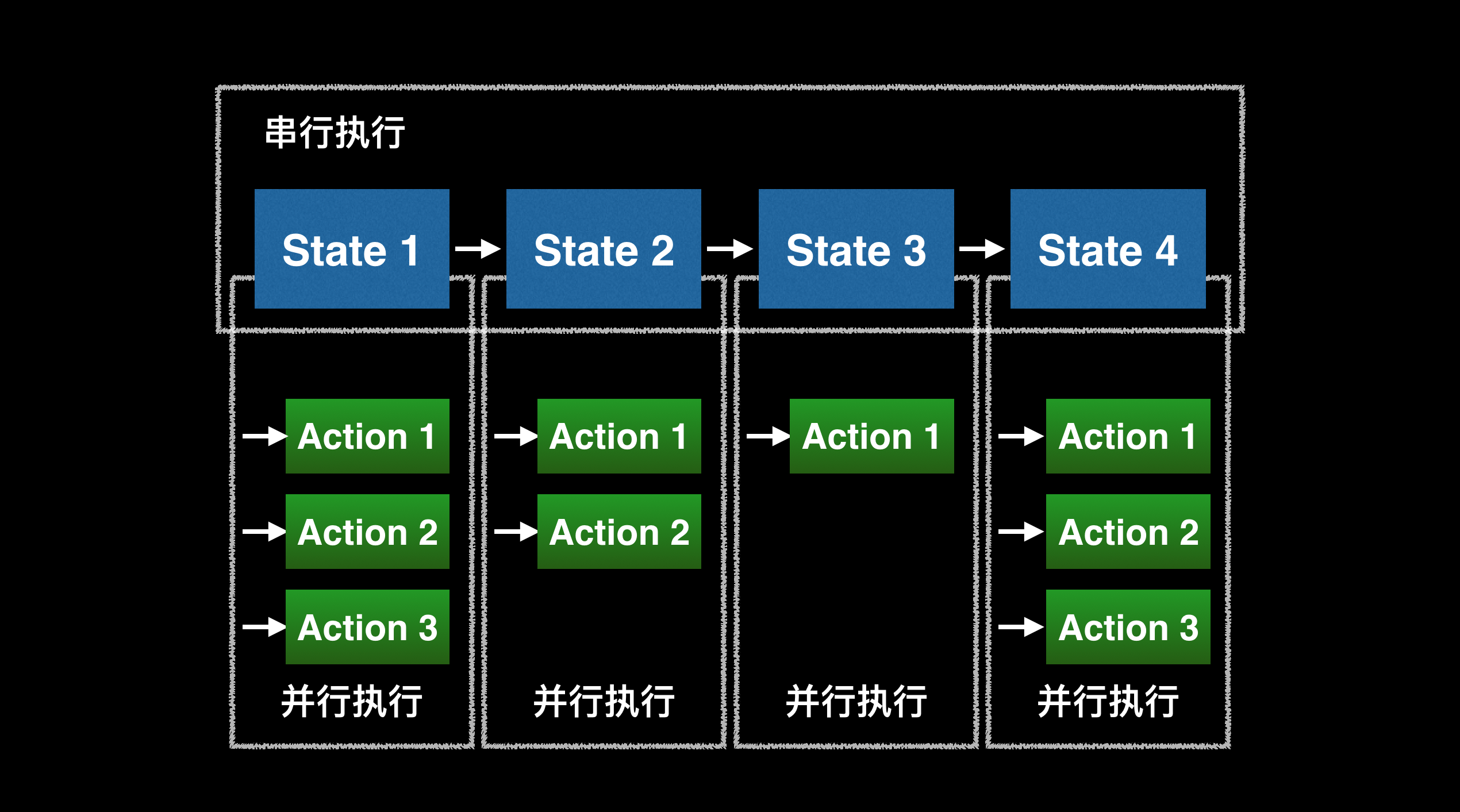两年前刚进公司的时候,第一次接触了异步框架,那时还处于懵懵懂懂的状态。最近换了组,接触到另外一种实现的异步框架,这次有了一定的积累后,对异步框架的设计也有了更多的理解。刚好最近自己基于 libuv 造了个简单的轮子 saf (Simple Async Framework),趁此机会和大家聊聊异步框架的设计思想和实现。
异步框架设计思想
服务器模型
先来看看传统的服务器模型,如下图:

一般来说,服务器端可以分为三层:接入层,逻辑层,数据层。接入层负责客户端的接入,逻辑层则实现业务逻辑,数据层就是数据的存储。
简单来说,逻辑层做的事情无非就是解析客户端的请求包,写入数据到数据层或从数据层读取数据,再组装回包发送给客户端。
我们拿微博做例子,用户登录微博,客户端发起拉取首页的请求,server 首先解析客户端请求,拿到用户 id,再根据用户 id 到数据层查询以下数据并拼装回包发回给客户端:
- 关注数
- 粉丝数
- 微博数
- 个人简介,包括头像
- 微博时间轴,即关注的人最近发的微博
同步 vs 异步
继续上面微博的例子,我们假设微博时间轴采用拉的方式去获取。 同步的 server,实现的逻辑如下图:

如果同步的 server 是单线程,那每次发送请求到数据层查询数据时都会阻塞,在收到数据层的回包前 server 做不了其他事情,CPU 在等待期间空转,非常浪费资源。
异步 server 则不会有这个烦恼,当 server 向数据层发送请求时会立即返回,此时 server 可以处理其它客户端请求,直到数据层返回所请求的数据,通知到 server,server 再继续之前的业务逻辑。流程图大致如下:

我们再仔细看上面的流程图,可以发现除了拉取微博时间轴需要依赖关注人列表之外,其它数据查询都互不依赖。因此可以把流程优化下:

通过这样的优化,耗时从
关注数请求耗时 + 粉丝数请求耗时 + 微博数请求耗时 + 个人简介耗时 + 时间轴耗时
缩减到
MAX(关注数请求耗时,粉丝数请求耗时,微博数请求耗时,个人简介耗时) + 时间轴耗时。
模型抽象化
通过上面的例子,来讲讲如何将上述异步处理逻辑抽象化。 我们可以把业务逻辑以状态(state)为单位来划分,如下图。状态与状态之间是串行的,即你必须执行完一个状态,才会跳转到下一个状态。比如我们必须先拉取关注列表,才能根据关注列表去拉取时间轴。

而一个状态内可以有很多动作(action),一个状态内的动作是互相不依赖的,即可以并行执行,如下图。如我们可以同时发请求拉去关注数,粉丝数,微博数,因为他们之间是互相独立没有依赖的。

异步框架的实现
讲完了概念,开始来实践。linux 下有 epoll 模型,另外还有大名鼎鼎的 libuv 提供了跨平台的异步 IO。那接下来结合我自己造的轮子,谈谈如何基于 epoll 或 libuv 来实现一个异步框架。
状态保存
无论是函数调用,或者线程切换,都会保存上下文,等到函数调用返回或线程切回来时,才能继续处理之前未完成的逻辑。而我们的异步模型(其实就是状态机),也是类似的道理,我们需要在请求发送时保存好上下文,才能在收到回包时继续之前的逻辑往下走。 saf 是基于 libuv 的,因此我使用 libuv 的 handle 结构体的 data 字段来保存上下文。如果是直接使用 epoll 来实现异步server,则可以用 fd 来绑定上下文(全局的 map,key 为 fd,value 为上下文信息)。
消息透传
既然各个状态是有依赖关系的,那就得有一个消息(message)实体贯穿整个处理流程。通过这个消息实体来传递各个状态所需要的信息。这也是为什么 saf 中 action 和 state 的接口都有一个 msg 参数的原因(见下节接口设计)。
接口设计
封装一个异步框架,意味着对于框架使用者来说其无需关心网络收发包的细节,只需关心自身业务逻辑的实现。那我们在设计接口上就需要屏蔽这些细节。
既然要对使用者屏蔽收发包细节,表明收包和发包的回调都由框架来控制。因此我们只需要暴露打包请求包和解包回包的接口给使用者去实现。框架调用使用者实现的打包接口后,将打好的 buffer 发送出去,在收到回包之后,再调用使用者实现的解包接口来处理回包。
在 saf 的接口设计中,我尽量保持接口命名的统一,prepareProcess 表示在执行前的预处理工作,afterProcess 表示执行完后的后续处理工作。下面可以看到在不同的模块中,prepareProcess 和 afterProcess 的功能略有不同。
消息类
1
2
3
4
5
6
//msg.h
class Msg {
public:
virtual ~Msg() {}
};
如上所述,消息用于状态之间传递依赖的信息,由业务自行继承添加所需成员。
Handler 类
1
2
3
4
5
6
7
8
9
10
11
12
13
14
15
16
17
18
19
20
21
22
//handler.h
/*
* 解析客户端请求包
* 返回 > 0 表示收包不完整
* 返回 0 表示解析成功
* 返回 < 0 表示解包失败, server将会杀掉客户端连接
*/
virtual int prepareProcess(char* buf, unsigned int len, Msg* msg) = 0;
/*
* 打包客户端回包到输入 buf 中,len 为输入 buf 长度
* 返回 > 0 表示 buf 不够, len 为实际需要的 buf 长度
* 返回 0 表示打包成功, len 为 buf 的实际长度
* 返回 < 0 表示打包失败, server将会杀掉客户端连接
*/
virtual int afterProcess(char* buf, unsigned int& len, Msg* msg) = 0;
/*
* 创建该 handler 的 msg
*/
virtual Msg* createMsg() = 0;
Handler 类对应客户端请求的处理流程。业务继承 Handler 基类,实现请求包和回包的打解包接口以及创建业务消息的接口。
在 Handler 的构造函数添加该 Handler 包含的 State。在收到客户端请求后,框架调用相应的 Handler 的 prepareProcess 接口对客户端请求进行解包。然后依次执行各个 State,全部 State 执行完成后,框架调用该 Handler 的 afterProcess 将回包打包到传入的 buffer 参数,再由框架将该 buffer 发送回客户端。
State 类
1
2
3
4
5
6
7
8
9
10
11
12
13
14
// state.h
/*
* 执行 state 包含的 action 前, 框架会调用该函数, 可以做预处理工作
* 返回 0 表示成功
* 返回 != 0 表示失败
*/
virtual int prepareProcess(Msg* msg) { return 0; };
/*
* state 包含的 action 都执行完时, 框架会调用该函数,可以做一些后续处理工作
* 返回 0 表示成功
* 返回 != 0 表示失败
*/
virtual int afterProcess(Msg* msg) { return 0; };
State 类对应上面模型抽象化小节的状态。
在 State 的构造函数添加该 State 包含的 Action。State 执行前,框架调用该 State 的 prepareProcess 接口,使用者可以在该接口做些预处理工作。当 State 执行完成后,框架调用该 State 的 afterProcess 接口。
Action 类
1
2
3
4
5
6
7
8
9
10
11
12
13
14
15
16
17
18
19
20
21
22
23
24
25
26
27
//action.h
/*
* 设置 action 的目的 ip,端口和通信协议(目前只支持tcp)
*/
void setActionInfo(const std::string& ip, int port, int protocol);
/*
* 设置 action 的超时时间,单位为毫秒。 <=0 为永不超时
*/
void setTimeout(unsigned int timeout) { m_timeout = timeout; }
/*
* 打包 Action 请求包到输入 buf 中, len 为输入 buf 的长度
* 返回 0 表示打包成功, len 为实际需要的 buf 长度
* 返回 > 表示 buf 不够, len 为实际需要的 buf 长度
* 返回 < 0 表示失败
*/
virtual int prepareProcess(char* buf, unsigned int& len, Msg* msg) = 0;
/*
* 解析 Action 回包
* 返回 0 表示解析回包成功
* 返回 < 0 表示出错
* 返回 > 0 表示收包未完整
*/
virtual int afterProcess(char* buf, unsigned int len, Msg* msg) = 0;
Action 类对应上面模型抽象化小节的动作。
Action 执行前,框架调用该 Action 的 prepareProcess 接口,将 Action 的请求包打包到传入的 buffer 参数,当收到 Action 的回包后,框架会调用 Action 的 afterProcess 接口,将回包解包。
REGISTER_HEADER_PARSER
REGISTER_HEADER_PARSER 宏用于注册解析请求包头函数。
REGISTER_HANDLER
REGISTER_HANDLER 宏用于注册请求对应的 handler 类
状态机逻辑
接下来看看 saf 如何将 handler/state/action 串联起来(代码有所简化)
1
2
3
4
5
6
7
8
9
10
11
12
13
14
15
16
17
18
19
20
21
22
23
24
25
26
//handler.cpp
/*
* 主逻辑,ClientContext 保存了客户端会话的上下文
* 其 m_state_idx 成员表示当前所属的状态 id
* m_action_idx 成员表示处于当前所属状态的动作id
* m_msg 即业务定义的消息类,被透传给 state 和 action 中
*/
void Handler::process(ClientContext* c_ctx) {
if (c_ctx->m_state_idx < m_state_list.size()) {
State* state = m_state_list[c_ctx->m_state_idx++];
// 执行 state 前, 将 action_idx 置 0
c_ctx->m_action_idx = 0;
// 调用 state 的 prepareProcess 接口
state->prepareProcess(c_ctx->m_msg);
// 开始执行该state
state->process(c_ctx);
} else {
static char buf[DEFAULT_BUF_SIZE];
char* actual_buf = buf;
unsigned int actual_len = DEFAULT_BUF_SIZE;
// 调用 handler 的 afterProcess 接口,打包回包到 actual_buf 中
afterProcess(actual_buf, actual_len, c_ctx->m_msg);
// 发送回包给客户端
c_ctx->sendResponse(actual_buf, actual_len);
}
}
1
2
3
4
5
6
7
8
9
10
11
12
13
14
15
16
17
18
19
20
21
22
23
24
25
26
27
28
29
30
31
32
33
34
35
36
37
38
39
40
41
42
43
//state.cpp
/*
* state 处理逻辑
*/
void State::process(ClientContext* c_ctx) {
// 如果没有action,直接finish
if (m_action_list.size() == 0) {
finish(c_ctx);
return;
}
static char buf[DEFAULT_BUF_SIZE];
char* actual_buf = NULL;
unsigned int actual_len = 0; // buf 的实际长度
int ret = 0;
// 执行该 state 下所有 action
for(unsigned int i = 0; i < m_action_list.size(); i++) {
Action* action = m_action_list[i];
actual_len = DEFAULT_BUF_SIZE;
actual_buf = buf;
// 调用 action 的 prepareProcess 接口,打包 action 的请求包到 actual_buf 中
action->prepareProcess(actual_buf, actual_len, c_ctx->m_msg);
// 执行该 action
c_ctx->processAction(action, actual_buf, actual_len);
}
}
// action 完成后回调该接口,如果所有action都完成,则调用下面的 finish 接口
void State::finishAction(ClientContext* c_ctx) {
printf("finishAction\n");
c_ctx->m_action_idx++;
if (c_ctx->m_action_idx >= m_action_list.size()) {
finish(c_ctx);
}
}
// 调用 state 所属的 handler 的 process 函数
void State::finish(ClientContext* c_ctx) {
afterProcess(c_ctx->m_msg);
m_handler->process(c_ctx);
}
1
2
3
4
5
6
7
8
9
10
11
12
13
14
15
16
//ClientContext.cpp
/*
* action 收到回包后的回调
*/
static void recvActionRsp(uv_stream_t *server, ssize_t nread, const uv_buf_t *buf) {
// data 字段保存了 action 的上下文
ActionContext* a_ctx = (ActionContext*) server->data;
a_ctx->recv_buf.append(buf->base, nread);
// action 的上下文中保存了客户端请求的上下文
ClientContext* c_ctx = a_ctx->c_ctx;
// 调用 action 的 afterProcess 接口
int ret = a_ctx->action->afterProcess(a_ctx->recv_buf.data(), a_ctx->recv_buf.len(), c_ctx->m_msg);
// 通知 action 所属的 state 该 action 完成了
a_ctx->action->m_state->finish(a_ctx->c_ctx);
}
样例
以下是 saf 的一个简单的 demo。代码仅说明用,所以比较简单粗暴。该 server 的所有请求都由 myHandler 来处理,myHandler 包含一个状态 myState1。myState1 包含一个 Action, 该 Action 将客户端请求包拷贝并通过 tcp 发送给 127.0.0.1:7000 的服务,接收到回包后再把回包原样发回给客户端。
1
2
3
4
5
6
7
8
9
10
11
12
13
14
15
16
17
18
19
20
21
22
23
24
25
26
27
28
29
30
31
32
33
34
35
36
37
38
39
40
41
42
43
44
45
46
47
48
49
50
51
52
53
54
55
56
57
58
59
60
61
62
63
64
65
66
67
68
69
70
71
72
73
74
75
76
77
78
79
80
81
82
83
84
85
86
87
88
89
90
91
92
93
94
95
96
97
98
99
100
101
102
103
104
//
// Created by Masutangu on 16/8/9.
//
#include "saf/header.h"
#include <cstring>
using namespace saf;
const int BUF_SIZE = 1024;
class myMsg: public Msg {
public:
char readbuf[BUF_SIZE];
char writebuf[BUF_SIZE];
};
class myAction: public Action {
public:
int prepareProcess(char* buf, unsigned int& len, Msg* msg);
int afterProcess(char* buf, unsigned int len, Msg* msg);
};
int myAction::prepareProcess(char* buf, unsigned int& len, Msg* msg) {
myMsg* my_msg = static_cast<myMsg*> (msg);
printf("myAction prepareProcess, data: %s\n", my_msg->readbuf);
if (len >= BUF_SIZE) {
memcpy(buf, my_msg->readbuf, BUF_SIZE);
return 0;
} else {
len = BUF_SIZE;
return BUF_SIZE;
}
}
int myAction::afterProcess(char* buf, unsigned int len, Msg* msg) {
printf("myAction afterProcess: %s\n", buf);
myMsg* my_msg = static_cast<myMsg*> (msg);
memcpy(my_msg->writebuf, buf, len < BUF_SIZE ? len:BUF_SIZE);
return 0;
}
class myState1: public State {
public:
myState1();
};
myState1::myState1() {
myAction* action = new myAction;
action->setActionInfo("127.0.0.1", 7000, 0); //设置action的ip和端口
addAction(action);
}
class myHandler: public Handler {
public:
myHandler();
Msg* createMsg();
int prepareProcess(char* buf, unsigned int len, Msg* msg);
int afterProcess(char* buf, unsigned int& len, Msg* msg);
};
Msg* myHandler::createMsg() {
return new myMsg();
}
myHandler::myHandler() {
myState1* state1 = new myState1();
addState(state1);
}
int myHandler::prepareProcess(char* buf, unsigned int len, Msg* msg) {
printf("handler: prepareProcess len=%d\n", len);
myMsg* my_msg = static_cast<myMsg*> (msg);
memcpy(my_msg->readbuf, buf, len);
return 0;
}
int myHandler::afterProcess(char* buf, unsigned int& len, Msg* msg) {
myMsg* my_msg = static_cast<myMsg*> (msg);
if (len >= 1024) {
memcpy(buf, my_msg->writebuf, 1024);
return 0;
} else {
len = 1024;
return 1;
}
}
int parseReq(char* buf, unsigned int len) {
return 1; // 该请求的类型为 1,由 myHandler 处理
}
int main() {
REGISTER_HANDLER(1, myHandler); // 请求类型为 1 的由 myHandler 类处理
REGISTER_HEADER_PARSER(parseReq); // 请求包头由 parseReq 函数解析
AsyncServer server = AsyncServer();
server.setBindAddress("0.0.0.0", 8000); // 监听 8000 端口
server.run();
}
总结
由于时间和能力有限,saf 目前来说非常简陋,也没有经过严格的测试。对于一个框架来说,要做的事情还有很多,比如日志模块的完善、性能分析和优化。不过,done is better than perfect. 最后,如有问题或意见,欢迎留言或者 email 我,也欢迎转载分享~